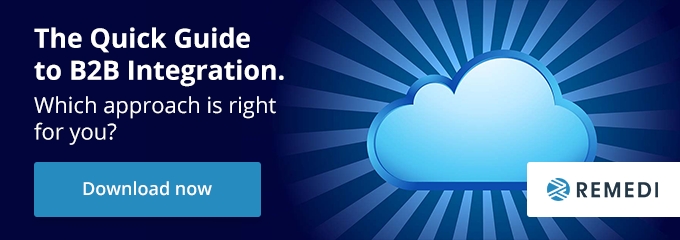Key takeaways:
- Event-driven architecture is well-suited for logistics operations.
- Don’t overlook robust security measures when implementing event-driven integration.
Event-driven integration refers to the way that different software systems respond to each other based on an event in one of the systems triggering an action in the other system. The event can be any predefined action unique to your organization and workflows. For example, a customer placing an order or package shipping from your warehouse are both examples of events.
Event-driven integration has particular relevance in the logistics industry because supply chains are dynamic and need real-time responsiveness.
The benefits of adopting event-driven approaches for real-time data handling and decision-making are numerous. Event-driven systems provide an immediate view into the internal workings of business processes and also enable organizations to react more quickly to market conditions because of the continual access to real-time data.
Understanding Event-Driven Architecture (EDA)
Event-driven architecture (EDA) is a software paradigm where the design is centered around events that influence information flow and trigger other actions. EDA differs from traditional integration methods in a few key ways. Traditional integration methods don’t provide a response without a preceding request. EDA doesn’t need a request; it responds as events occur. Due to loose coupling, EDA is easier to maintain and update and is also more scalable.
EDA consists of multiple components including event producers, event routers, and event consumers. These components work in tandem to enable information flow. Event producers, also known as publishers, generate events within the system by looking for a change in state. In logistics, sensors on the factory floor are an example of event producers.
Event routers act as the intermediary between producers and consumers. They filter or route events based on subscriptions or a set of predefined rules. Event consumers are known as subscribers and act as event recipients.
Identifying Key Integration Points
In order to identify critical processes in logistics that can benefit from event-driven integration it’s important to understand the flow of operations before identifying any inefficiencies or opportunities for improvement. Analyze your organization’s existing supply chain to determine areas where real-time data can increase visibility and improve responsiveness. Examples of integration points include inventory updates, order management, and shipment tracking.
Technology and Tool Selection

It’s important to select the right tools and technologies when implementing an event-driven system as these choices will significantly impact how the system performs and how easy it will be to maintain. It will also have an effect on its scalability.
Take a close look at your system’s requirements including both the technical and business aspects. Determine your needs while taking into account reliability, scalability, and latency. Evaluate middleware providers and message brokers that meet the criteria you’ve determined are important. Determine whether or not the option can handle your event load and evaluate other features including security features, monitoring capabilities, and vendor support.
Designing for Scalability and Reliability
When your organization sets out to design an event-driven system that is scalable and reliable under operational demands, start by clearly identifying the use cases and anticipate projected load volumes. Implement microservices for specific functions. Horizontal scaling will allow your system to handle increasing workload and event volumes.

There are multiple considerations to take into account so that your system can ensure high system uptime and handle high data volumes. Focus on creating a scalable infrastructure by using cloud services and containerized environments. Distribute processing across multiple nodes to optimize performance.
Ensuring Data Security and Compliance
Ensuring data privacy and confidentiality is a main concern in event-driven systems due to the sensitive nature of information exchanged. Authentication and authorization can be a challenge because of the multiple systems and services interacting through event-driven integration.
Best practices for encrypting event data and ensuring compliance with industry regulations include implementing end-to-end encryption to protect data while in transit and at rest. Additionally, robust authentication and access control methods are a must due to the routing components in event-driven integration.
Developing a Phased Implementation Plan
Implement event-driven integration through a pilot project based on a step-by-step approach will help to validate the benefits of your selected approach before scaling more broadly across your entire logistics operations. Identify your business objectives upfront with feedback from key stakeholders and decide on expected outcomes.

Iterative testing and feedback to refine the system will help validate your system’s functionality and ensure it performs optimally.
Training and Change Management
It’s important to train staff on new tools and processes to make sure they’re well-equipped to perform their roles efficiently. Training will ensure they can leverage all the capabilities of the new system while increasing productivity and efficiency.
Involve stakeholders from the beginning and clearly communicate the benefits of your proposed changes involving event-driven integration.
Monitoring and Continuous Improvement
Ongoing monitoring is important to track the performance of event-driven systems and will ensure KPIs are met. Continuous monitoring helps to detect issues in real-time so they can be addressed before they severely impact your logistics operations.
Monitoring can provide performance metrics that your organization can analyze to identify factors that contribute to reduced performance. You can also analyze event data to optimize processes and increase efficiency.
Case Studies and Success Stories
Amazon is a very notable example of how event-driven integration has transformed logistics operations by allowing Amazon to automate their warehouse operations through use of Kiva robots. The takeaway is that it’s possible to integrate event-driven systems with physical processes successfully.
UPS is another example of an organization that has been transformed by event-driven integration. They use an event-driven route optimization system to determine the most efficient delivery routes for their drivers taking into consideration traffic conditions and any package pickups.
Conclusion
The strategic advantages of adopting event-driven integration in logistics include better visibility into your logistics operations, improved operational efficiency, and greater scalability and agility.
If you’re a logistics manager or IT professional, you should take advantage of all the benefits that event-driven integration can provide your logistics operations.
The Quick Guide to B2B Integration.




